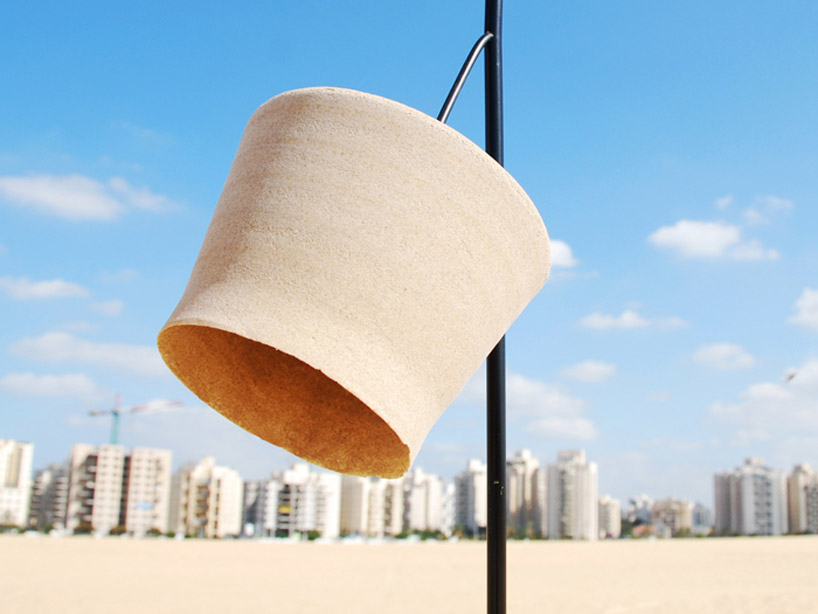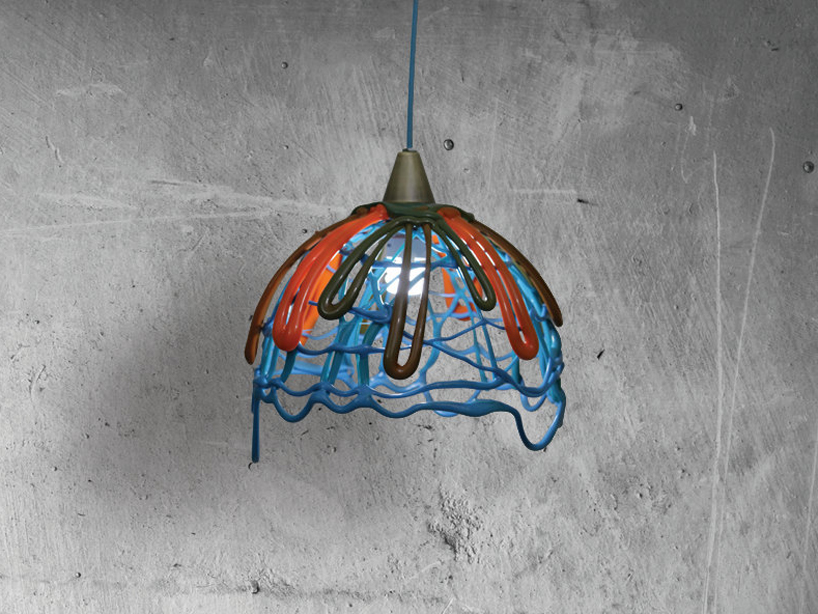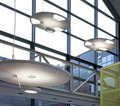sand moulded desert storm lamp by nir meiri
by: Designboom - Weblog, 2011-10-26 09:30:00 UTC

sand is molded and tamed to create a lampshade which comments on the tension between the nature of the material from which it is made, and its resulting form.
read more
frozenplastic studio: recycled plastic amorph lamp
by: Designboom - Weblog, 2011-10-28 11:45:00 UTC

recycled bags and bottles are given a new form and purpose when they are melted down and hand-poured into pendant lamp shades.
read more
Calif. Sues Firms Over Degradable Bottle Claims
by: Environmental Leader, 2011-10-28 06:12:35 UTC

Bottle manufacturer ENSO Plastics and drinks companies Aquamantra and Balance Water are being sued by the California attorney general’s office over claims that they misled customers by falsely marketing water bottles as biodegradable, the Huffington Post reports. ENSO is accused of falsely claiming that its bottles would biodegrade in less than five years, leaving behind [...]
 Friday Giveaway: 01M ONEMOMENT Biodegradable Shoes
Friday Giveaway: 01M ONEMOMENT Biodegradable Shoes
by: Yanko Design, 2011-10-28 07:00:29 UTC
Very rarely do you come across a product that is functional, forward fashion, ecofriendly and harmonious in design. 01M ONEMOMENT Biodegradable Shoes is this and more! We love this pair so much, that after writing about it on YD, we decided to host an exclusive giveaway for our readers giving them a chance to sample the world’s lightest shoes upfront. Five Hampers of 3-pairs each (15 shoes in total) are up for grabs. All you need to do is follow the contest rules below…

To Win
- Leave in the comments below which country you are from and where will you wear your 01M ONEMOMENT Biodegradable Shoes
Contest Rules
- Only One Entry Per Person
- Contest Closes October 30 2011, midnight.
- Standard Contest Rules Apply
- 5 winners will win 3 pairs of shoes each, in colors of their choices
- Contest open worldwide
Double Dip Treat
More About 01M ONEMOMENT Biodegradable Shoes
Figtree Factory Studio is a Spanish company that manufactures the 01M ONEMOMENT Shoes. These are the world’s first 100% biodegradable shoes and the lightest as well! They exude a barefoot sensation and offer natural comfort. Packages in a biodegradable blister pack, these shoes fit in any bag, pocket or store display! Sizes available are XS, S, M, L and they come in a range of colors to choose from.

Get social with Figtree, you can visit their site, blog, Twitter, Youtube and Facebook, to connect with them!



----------
Yanko Design
Timeless Designs - Explore wonderful concepts from around the world!
Yanko Design Store - We are about more than just concepts. See what's hot at the YD Store!
(Friday Giveaway: 01M ONEMOMENT Biodegradable Shoes was originally posted on Yanko Design)
Seven solar powered timepieces for eco geeks
by: The Design blog, 2011-10-28 12:22:49 UTC
Dino Renthlei:

solar powered timepiecessolar powered timepieces
The power of the sun has always been waiting to be harnessed. This endless supply of energy is more than enough to satisfy our needs and wants. But the technology needed can be expensive while lack of initiative by governments worldwide add to the inability of the human race to be better able to make use of this life giving force. Even so, this hasn’t stopped people from coming up with very interesting concepts that run on the power of the sun. Check out these watches that have been designed keeping in mind the environmental consciousness of people.
1. Nixon Volta solar powered watch

Nixon Volta solar powered watchNixon Volta solar powered watch
This solar powered watch by Nixon is one good looking timepiece. Sturdy and vintage looking, it is the company’s first solar powered watch since its inception 11 years back. The dial, which is semi-transparent, invites the sun’s rays down to the solar panel which recharges the watch’s batteries. Made out of stainless steel casing, hardened mineral crystal and a crown filled with triple gasket enamel, the Volta is perfect for the outdoors. Double sided leather strap and a stainless steel buckle complete the look. You can recharge it by placing it near a source of light like a desk lamp for an hour and get a day’s worth of power. But if you place it directly under the sun for an hour, you’ll get 60 days of time. Tough and classy, wearing the Volta means never having to worry about your battery going out.
2. Solar powered mechanical watch

Solar-powered Mechanical WatchWorld’s First Solar-powered Mechanical Watch
The world’s first solar powered mechanical watch has arrived. Designed by Cabestan Watches, it has been named Sol Invictus and costs a huge $560,000. As expensive as it may be, the Invictus does come with some cool features. It incorporates the antique fusee and chain, vertical tourbillion and drums. Silicium crystals will be used to produce solar cells which will harness the sun’s energy and power the watch. Each piece will be created according to clients’ specifications so you know you’ll be sporting a one of a kind piece. And while the price leaves something to be desired, you can’t deny that it is a stylish combination of advanced technology and electromechanical engineering.
3. Solaris series concept watches

Solaris Series Concept WatchesSolaris Series Concept Watches
Concepts are always so awe-inspiring and the Solaris series designed for Tokyoflash is no different. Created by French designer, Oliver, the watches are nothing like conventional timepieces. Looking more like hi-tech gadgets, these watches make use of solar cells that harness the sun’s energy which lights up the LEDs on the face. A cross bar in the middle indicates the four quarters of an hour, while purple LEDs make up the five minute groups. And just in case you don’t get any sun, Oliver has thoughtfully put in a battery as well so you can never lose track of time.
4. Boiler solar powered watch

Boiler Solar-powered WatchFreestyle Boiler Solar-powered Watch
Solar powered watches are all very well and good, but have you heard of one that functions for a whole year on a single charge? Freestyle’s Boiler watch does just that. This digital timepiece has a sleek looking face which is perfect for the fashion conscious. Retailing for $115, Boiler is well priced in view of its looks and eco friendly concept.
5. Citizen stainless steel eco drive

Citizen Stainless Steel Eco-driveCitizen Stainless Steel Eco-drive Atomic Perpetual Mens Watch
This analog chronograph watch by Citizen is one manly looking device. Stainless steel straps and case and a black dial make this piece perfect for men. Conventionally designed, the only difference is that it runs using the sun’s energy.
6. Shuo Yang designedsolar powered clock

Shuo Yang designed Solar powered clockShuo Yang designed Solar powered clock
Ever heard of a clock with no face? Well, Shuo Yang has come up with a solar powered clock made entirely out of recycled paper that has no face. Hitting two birds with one stone, Yang has attempted to not only save batteries, but also cut down on the use of metal with his ingenious device. The hands of the clock are attached in circles to follow time while the empty face allows you to fill up the device by sliding in your favorite picture. Named Empty Time, the clock is truly innovative.
7. Solar powered clock

Solar-powered clockSolar-powered clock
Designed by Vienna-based Vandasye design studio, the solar powered clock has been built for interior spaces so it has a large capacity to absorb solar energy. It has a backlit display and while the aesthetics may not be as high up there as other such timepieces, the large solar panel means that it harnesses a lot more energy than other clocks. Currently a prototype, it could be a while before it hits the market.


 How to create your own water powered clock
How to create your own water powered clock
by: The Design blog, 2011-10-29 06:14:05 UTC
Satyajit Bera:

Water powered clockCreating your own water powered clock
DIY battery cells are very exciting to make at home. It becomes more interesting if the raw materials are easily available and cheap to your wallet. In this project we will use water as the electro-chemical solution in which the electrodes will remain immersed. This cell works on the principle of ion exchange between the water and the metal electrodes. The salts and acids present in tap water migrates to the electrodes causing the flow of electron particles, thus yielding electrical power. Though the output voltage of this cell is too small, it is sufficient to drive a low voltage digital clock.
Difficulty level: Moderate. You may require basic knowledge.
Time required: The maximum time required for this project is 1 hour.
Resources required:
1. Two empty bottles or jars to store the water (capacity - 1 liter)
2. Connecting wires (one red colored, one black colored and the last one of any other color)
3. A low voltage digital display clock
4. Two copper leads
5. Two zinc leads
6. A thick needle to punch holes
7. A soldering iron
8. Transparent adhesive tape
Estimate cost: The average cost involved in this project is about $1-$2 (if you buy the copper and zinc leads).
Instructions
- First, make the electrodes of the water cell. Connect the red wire, that is the positive terminal to a copper lead and the black wire or negative terminal to a zinc lead.
- Now use the left wire of any other color to connect the rest two pieces of leads. This interconnected electrode assembly is used to connect the two water cells in series in order to double the output voltage.
- Next, fill two bottles or containers with tap water and place them side by side. Punch two holes (with the needle) in each of the bottle caps for fixing the metallic electrodes inside the bottles.
- Now, insert the positive copper lead inside the left bottle and the negative zinc terminal inside the right bottle. Thereafter, put the zinc lead of the interconnected electrodes assembly into the left bottle (having a copper lead already) and the copper lead into the right bottle (having a zinc lead already).
- Take out the dead battery from the digital display clock and identify the positive and negative terminals very carefully.
- Next, connect the positive (red wire) and negative (black wire) terminals from the water cell to the corresponding points in the clock with the help of a soldering iron.
- Fix the clock to the bottles or any fixed support with the help of the transparent adhesive tape.
- You have completed making a digital clock powered by the electro-chemical energy of water. As soon as you connect the terminals, the display will flash up and show you time (you will have to adjust the time for the first time).
Frequently asked questions
1. How long will this water powered cell work?
Well, this one is going to work satisfactorily up to 1 month or so without affecting the display. However, if the water used bears more salt (varies from place to place), the cell will work effectively for a longer time. After that just change the water of the two bottles to recharge the cell.
2. How can I make this clock look attractive?
You can make use of a box, cut a hole in the front to mount the clock, place the bottles inside and color the outer surface to make it look stylish and beautiful.
Quick tips
1. Always use a low voltage digital clock for this project. It is because the output voltage of the water cell used here is very minimum. Thus, you should use a clock which uses very less power to run.
2. Change the water in the bottles at least once in a month to get best results.
3. Don’t use thick wires for the connections. This will cause the voltage to drop as a result of which your clock may not turn on.
Things to watch out for
1. Make sure that you don’t short the positive and negative terminals in any part of the entire circuit. This may damage the internal circuitry of the watch and ruin it.
2. Make sure that there is no leakage of water from the bottles, or they will flood your table.
3. Identify the positive and negative terminals at the back of the clock very carefully. Never connect the wrong wire to the wrong terminal.
4. Don’t forget to maintain the color code of the wires as described above. This will help you avoid any confusions. Always connect the red wire (positive terminal) to the copper lead and the black wire (negative terminal) to the zinc lead.


 Nest Learning Thermostat learns user habits and programs itself
Nest Learning Thermostat learns user habits and programs itself
by: Gizmag Emerging Technology Magazine, 2011-10-26 14:06:03 UTC

While programmable thermostats are nothing uncommon these days, many users adjust the temperature manually utilizing the thermostat's basic feature only. On the other hand, it's certainly difficult to develop an appropriate program corresponding to the volatility of daily life. Designed by a team led by ex-Apple engineer Tony Fadell, the Nest Learning Thermostat offers a new take on automatic temperature adjustment. Featuring a simple knob-based design, the unit is capable of self-programming itself via a combination of its user's habits, activity sensors and Internet-gathered weather information, thus increasing energy savings without much effort on the user's part...
Continue Reading
Nest Learning Thermostat learns user habits and programs itselfSection: Around The HomeTags: Energy-saving,
Heat,
Home,
Temperature,
Thermostat
Related Articles:


 BYD's all-electric e6 hits the market - 87 mph and a range of 190 miles
BYD's all-electric e6 hits the market - 87 mph and a range of 190 miles
by: Gizmag Emerging Technology Magazine, 2011-10-27 12:13:08 UTC

One of the stars of the Chinese automotive industry is Shenzen-based BYD, which although only sixth largest of the Chinese manufacturers, had the country's top selling individual vehicle last year in the form of the BYD F3 (a Toyota Corolla E120 clone). Now, after substantive testing of its e6 all-electric model in taxi and company fleets, the five-seater 75 kW, 87 mph crossover has gone on sale to the Chinese public, with a (claimed) range of 300 km (186 miles), which would give it the longest range of any EV in the world at present. It also has a smartphone-based information system which seems at least as advanced as anything currently available anywhere...
Continue Reading
BYD's all-electric e6 hits the market - 87 mph and a range of 190 milesSection: AutomotiveTags: BYD,
Crossover,
Electric Vehicles,
Li-ion,
Plug-in Hybrid,
Rechargeable Batteries,
Smartphone
Related Articles:


 6 Eco Burial Options for a Green Afterlife
6 Eco Burial Options for a Green Afterlife
by: Inhabitat , 2011-10-27 22:17:35 UTC







Read the rest of
6 Eco Burial Options for a Green Afterlife
Permalink |
Add to
del.icio.us |
digg
Post tags: 3-D printers, and vinyly, cremation ashes, eco design, Eternal Reefs, green design, Life Gem, Nadine Jarvis, shelves for life, sustainable design, Wieki Somers, William Warren
Printable Solar Panels Now Powering The National Guard
by: fast company, 2011-10-26 16:56:21 UTC
Nanosolar, which uses an innovative method to get roofs covered with solar panels, is busy outfitting Guard bases around the country. The nation's biggest energy consumer should be its biggest solar customer.

Someone forgot to tell the U.S. military that, after Solyndra's collapse, the government was supposed to be shying away from solar energy. The military has already signed a lease for a massive amount of solar panels for housing on bases around the country, and the National Guard is now exploring the potential of thin-film solar panels. Nanosolar, which makes a solar ink that can be printed on anything (including, say, a roof) just provided panels for a solar installation a Guard base in Ohio.
Nanosolar uses a proprietary nanoparticle ink that be simply printed onto aluminum sheets to make solar cells. This process has the potential to be much faster and cheaper than making traditional solar panels, and that’s what makes it so exciting. If solar panels can be cranked out like newspapers, the cost of renewable energy could fall precipitously.
Earlier this month, a solar installation at Camp Perry Ohio National Guard Base went online using 2,750 Nanosolar Utility Panels. The installation has a capacity of 538 kilowatts-peak. That means that, when operating at its absolute peak, the system will produce 538 kilowatts of power. To put that in perspective, the average American household used 12,773 kilowatt-hours of electricity for all of 2005. Were the Camp Perry installation to run at its theoretical peak for a full 24 hours, it could provide a family with a year’s worth of electricity.
Another solar installation using Nanosolar panels, at Camp Roberts National Guard Base near Paso Robles, California, is in its final design phase now. It’s expected to enter construction early next year.
Both projects are being funded by the U.S. Department of Defense’s Environmental Security Technology Certification Program (ESTCP), which was launched in 1995 to test cutting-edge technologies that “address DoD’s high priority environmental requirements.”
After all, the military is the largest single consumer of energy in the United States, and has a vested interest in developing energy sources that are renewable, cheap, and fast to install. As Nanosolar VP of Worldwide Sales Brian Stone said, “we absolutely
believe that the U.S. military is a very important future customer for
our technology.”
[Image: Flickr user expertinfanty]













Comments by our Users
Be the first to write a comment for this item.